I recorded the bass guitar lines over the course of 2 days, completely recording 2 bass guitar lines on the first day and 3 on the next. I did the setup and recording processes alone, as I was confident in my abilities in the studio. The techniques I used to play the bass guitar and record it were the same on both days.
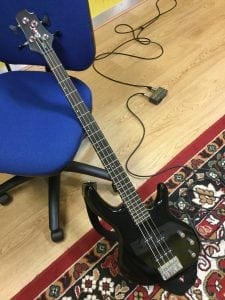
This is the bass guitar I used for the recording process. It is a Cort Action PJ bass guitar, and it is a bass guitar that I have owned for around 6 years. I decided to use my own bass guitar for this recording simply because I knew how best to play it, and I did not want to try using a bass guitar I was not familiar with for the recording. In the image, you can also see that it is plugged into a DI Box, which was an essential part of the recording hardware that I will now explain.
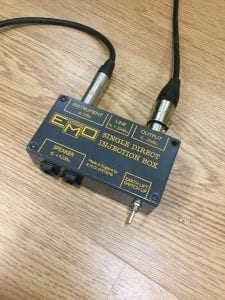
This is the DI Box previously mentioned, formally known as the EMO Single Direct Injection Box. Its purpose is to take the signal from a guitar/bass guitar (through the jack – jack lead plugged into its left side, the other end of it being plugged into the bass guitar I used) and send it through to an interface using an XLR cable, which looks like this:
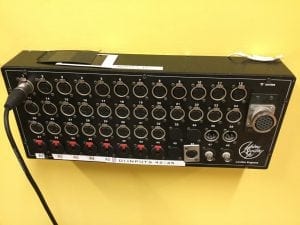
This then links it through to the mixing desk and the computer attached to that desk, which looks like this:
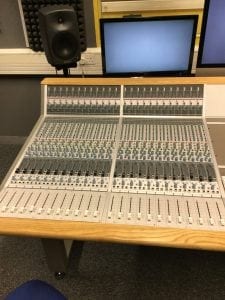
The reason I chose to use the DI Box for my recording process is due to the adaptability of the sound it produced, since it transmitted the raw signal from the bass guitar with no extra effects added. This allowed me time to add and edit the effects on the sound afterwards, to create the sounds I needed using the effects I wanted outside of the studio, allowing me to plan ahead and schedule when I wanted to work on the effects.
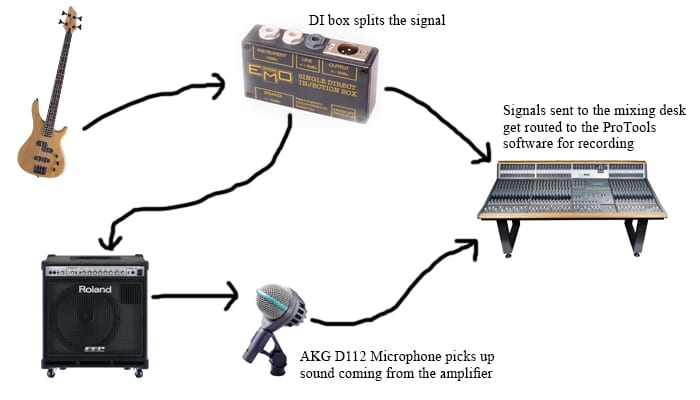
If I had had enough time, my setup would have looked something like this (not necessarily with the same microphone, although the AKG D112 is good at picking up bass guitar signals from the amp so it might have been the one I would have used). It is a typical recording technique which allows the raw signal to be sent to the desk and then through to the ProTools software as well as being sent to the amp and microphone, which then sends that signal to the desk as well, so you have multiple sounds to use. It would have taken too long to use the bass guitar amp with the microphone in front of it because it might not have produced the sound I wanted, because I have used this setup before in previous assignments and I understand that the sound produced would have been distorted (where the input is overloaded to create a ‘dirty’ sound) and not necessarily the correct sound for all of my songs. In addition, it would have taken too long to set up during each session, giving me less time to record the bass guitar riffs. Due to the time constraints I had to record the sessions, I would not have had enough time to use the technique in full, so I simply opted to remove the bass amp and microphone from the technique to save time in the studio.
In regards to playing the bass for the recording, however, I discovered and used another technique which some famous bass guitarists use to play it. Some bass guitarists favor using plectrums (“a small, thin piece of plastic, metal, etc. that is held between the fingers and thumb and used for playing instruments such as the guitar“) to play their instrument (me being one of those people), but due to me forgetting my plectrums at home on the first day, I decided to improvise and play using a 50p coin instead. As it turns out, it is not that much different compared to using a plectrum, except that the coin is much tougher and would not bend when plucking the strings, although it is shaped in such a way that makes it harder to play. I was curious to research playing guitars and bass guitars with coins after the recording sessions, and this allowed me to discover that it is a viable technique for playing, as Brian May (Queen‘s guitarist) used an old British sixpence coin to play his guitar because “he found plastic picks too flexible” (http://www.feelnumb.com/2010/11/02/queens-brian-may-uses-a-sixpence-english-coin-instead-of-a-guitar-pick/), and apparently Billy Gibbons from ZZ Top used a Mexican peso as a pick as well. Brian May even had some sixpence coins especially minted and sold them on his first solo tour. This was an excellent discovery because I did not think using a coin was a viable option to replace the pick, since coins are stiff and harder to wield in such a manner, at least from my experience in the recording sessions, but it was thanks to this research that I went back in on the second day and used a 50p coin to again play the bass lines, wanting to keep consistent with the sounds recorded on the first day.

